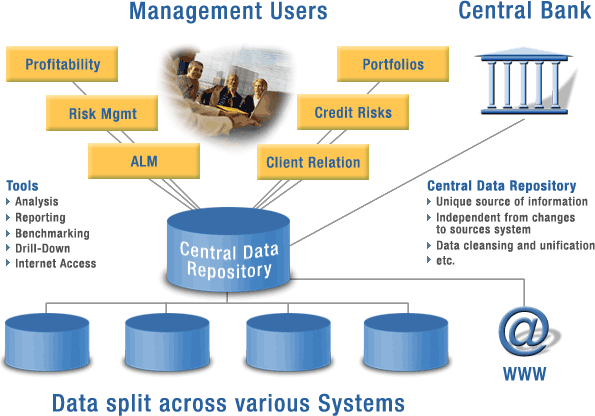
Challenge

In the current market situation - more than ever - modern bank management needs up-to-date, comprehensive and focussed information. Rapidly changing business conditions require flexible management responses where standardised information is no longer sufficient
On the other hand - without doubt-in every bank there is a huge reservoir of data within the various IT systems implemented at the bank. The challenge is to meaningfully and timely exploit the data and make it usable for the bank management in order to compete successfully in difficult market situations, i.e. to turn data into information.
What matters is Business Intelligence!
Solution

The solution is widely seen in a Data Warehouse where all required data is collected, analysed and processed for presentation.
However, there are many loopholes in this solution: Using the "MIS"-Module of the core banking package omits the data of other important applications. And what happens to the MIS when the banking system needs to be replaced? But following the opposite approach, everyone is aware of the risk of a comprehensive data warehouse project and stories about such failed projects are widely known.
Our Approach

Our approach is strictly business driven: which data and which options to view, analyse, interpret, and present the data are required, to produce the business intelligence that you need to take the right management decisions - and quickly.
Maintaining a business view helps us to avoid the mistakes of more "technically driven" projects. Based on an intelligent application architecture and modern EAI middleware we collect or access the required data from wherever they are and immediately turn them into business intelligence may that simply involve intuitive presentation or require more sophisticated OLAP processing or profitability/risk analysis.
From this understanding we work with our clients in well-defined and straight forward steps:
 |
 | Detailed discussion and determination of what the MIS is expected to deliver |
 | Data analysis of the existing systems and data bases |
 | Flexible data storage design involving data marts or distributed data sources as beneficial |
 | Concept and detailed EAI-architecture |
 | ETL processing |
 | Data quality control and data governance |
 | Tool and supplier selection, tendering processes where necessary |
 | Phased business-area-focussed implementation to provide benefits as early as possible |
 |

|

